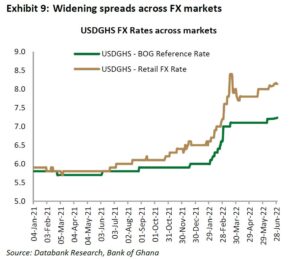The lingering exposure of the Ghanaian economy to foreign portfolio outflows remains a high risk, as a result of the sizeable outstanding holdings of non-residents in domestic bonds.
Notwithstanding the sharp decline in forex reserves in the first 4-months of the year, the non-resident holdings in domestic bonds remain elevated at GH¢26.8billion, equivalent to US$3.63billion as of June 2022, thus, reducing by 6.6 percent year to date (YTD).
In view of this, Databank, an asset management company, has raised concerns that foreign portfolio outflows could prolong the decline in forex reserves amid the limited FX supply options.
“Ideally, investors would be less concerned if the decline in gross reserves was matched by a corresponding decline in non-resident holdings in domestic bonds. However, the outstanding holdings structure suggests lingering exposure to foreign portfolio outflows.
“Given the loss of forex reserves, offshore investors continue to express doubts over government’s capacity to meet its external debt service obligations and the foreign portfolio outflows,” the investment firm said in its outlook for the rest of 2022.
“In view of this risk-off posture amid the depleted forex reserves, we perceive further depreciation pressure on the local currency in 3Q22,” Databank said.
The Ghana cedi struggled to stabilise in the first half of 2022 (1H22) due to inflation uncertainty and limited forex reserves. The country’s loss of access to international funding in 1H22 exposed the cedi to intense depreciation pressure.
The Bank of Ghana’s policy tightening, which commenced in late March 2022, partly eased the pressure in April 2022. However, the local currency suffered renewed pressure from May 2022 due to dividend and coupon repatriations, FX-debt service obligations, rising import bills, and a general flight to safe-haven currencies.
Compounding the struggle was the absence of the regular Eurobond inflows which also caused the gross forex reserves to decline by US$1.4billion in the first 4 months of 2022 to US$8.3billion, equal to 3.7 months of import cover in April 2022. This depletion in gross reserves has deepened the pressure on the local currency.
The investment firm also suggests that the prevailing consumer inflation uncertainty could further sustain demand for forex as a safe-haven asset.
Consumer inflation data showed a 29.8 percent year-on-year (y/y) increase in inflation in June 2022 from 27.6 percent in May 2022, reflecting elevated domestic food, petroleum and transport prices, as well as the pass-through effects of a weaker cedi. This marked the 13th consecutive increase and the highest inflation print since January 2004.
“With inflation elevated above domestic yields, local investors continue to hunt for safe havens to preserve capital and real returns. This strategy has increased the appeal of US dollar and USD-denominated assets such as the highly discounted Ghana Eurobonds.
“We believe the associated FX demand for safe-haven investments would exert depreciation pressure on the local currency in 2H22,” the investment firm stated.
Consequently, the firm maintained its 2022 forecast for the BoG interbank reference rate at GH¢7.56/US$1 (±GHp10) but increased the midpoint retail FX rate to GH¢8.35/US$1, against the previous forecast of GH¢7.97/US$1.
“On the FX forward market, we also expect the widening inflation differential between the US dollar and the GH cedi to exert depreciation pressure on the forward USD/GH¢ FX rate,” Databank said.
Easing of depreciation
Notwithstanding the underlining risks, the much-anticipated syndicated loans and the annual cocoa loan syndication should support FX reserves, partly addressing the struggle of the local currency.
This month, Parliament approved US$750million out of the US$1billion presented for approval, with immediate disbursement expected as a deal has already been agreed with lenders.
Furthermore, the market anticipates Ghana COCOBOD to conclude its annual cocoa loan syndication by the end of September 2022, ahead of the 2022/23 crop season, following approval by Parliament last week.
“We expect a target syndication size of US$1.5billion for this year with the deal to be concluded in late September 2022, and the first tranche disbursed in early October 2022.
These USD inflows, potentially up to US$2.5bn, should prop up the gross forex reserves between 3Q22 and 4Q22 to cap the potential depreciation pressures,” the report added.











